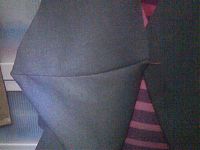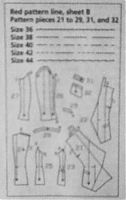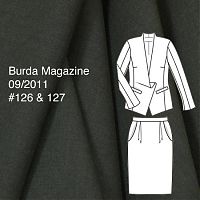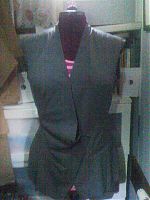Last weekend I cut out all the pieces for my upcoming draped suit, Burda September 2011 #126 and 127, in the beautiful grey stretch wool suiting I’d bought specifically for it.
Since then, though, progress has been slow. I’ve got an evening class for work every Monday night, I’ve found a wonderful, brilliant amazing running club I go to on Tuesdays, and our weekends are still chock full of boat DIY work as we scramble to get the last outside work done AND the insulation up before the weather turns. Which leaves exactly three evenings left for all of our social activities, and any sewing left to squeeze in. This week I’ve got something on all three of those evenings, too.
So this really leaves progress to be made in very small segments. I’m very good at finding spare ten minute pieces of time here and there, but lately even these have been thin on the ground. Over the past week, I only managed to work on this jacket twice – on Wednesday night I fused all the necessary pieces with Pam’s weft-insertion interfacing and vilene bias tape, and then Sunday afternoon I actually managed to get a few hours of sewing done once I’d done 3 hours of insulation work and the dust settled enough in the hold for me to get out my ironing board.
Beyond that, while we were working on the construction part of the boat, something happened to the 24v cabling and so the lights in the bedroom, sewing room, and one other area no longer work. So my sewing room is very dark now, even when it’s light outside! Please accept my double apologies for the quality of these photos – I had to light the area with a headtorch while taking these on my (soon to be upgraded, yayyy!) old iPhone 3G camera.
But enough with the downers, because this jacket is a total JOY to sew. Burda have seriously outdone themselves with this pattern. It is beyond beautifully drafted – it is exquisitely drafted. I probably only need to say three words: “three part sleeve”, but it doesn’t stop there! The sleeve hems have a curved facing instead of a turned-up hem, and the inset corners (four in total) on the shawl-like collar and interior back facing slip together perfectly, too.
But my favourite little detail is that the right front piece has a beautifully drafted self-facing which means there are no seams along either draped edge. There are essentially two triangles added on to the pattern which are sewn together and flipped to the inside. It’s a truly beautiful detail!
Here you can see the seam inside where the facing pieces join:

Here’s a look at the pattern pieces. Sorry about the quality, but you can see how the piece looks for this (piece 21, in the lower right corner here):

This really makes me wonder if this is an unlabelled designer pattern?? There wasn’t a designer pattern in this issue, so perhaps this was already drafted and ready to go, but they couldn’t put the designer name on it at the last minute? Or maybe Burda’s drafting team just had a bunch of extra time on this issue since the bulk of the magazine is rehashed dirndl patterns they’ve printed a thousand times before…
Oh and the other notable detail I’ve sewn here are the single welt pockets – I had used the “Couture Sewing Techniques” method on my winter coat, but thought I’d try Burda’s method here (very well documented by Sigrid in a pdf, but I can’t find its link anywhere!). But I’ll go back to Susan Khalje’s method in the future, because with Burda’s, if you are even one millimetre off (no exaggeration!), you’ll either see the joining seam, or the welt won’t fit in the hole properly. And then you’ll have to fudge it with handstitching anyway. So best to just handstitch the whole thing and get a beautiful result without the fudging, I think. My welts look fine here, if you don’t look too closely. I should remember this in future!
Looking ahead this week, I don’t think I’ll be able to do much on this (beyond perhaps sewing the sleeve facings down inside), but hopefully I’ll get a chunk of time at the weekend again to progress further.


